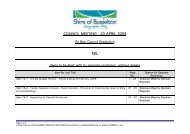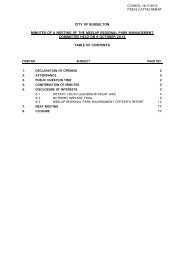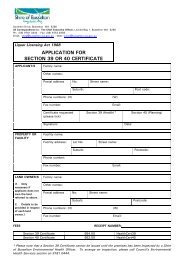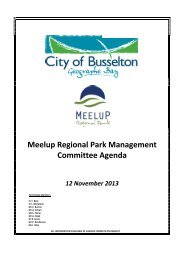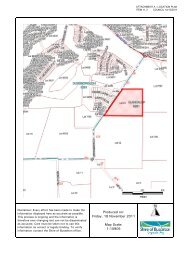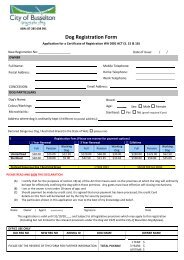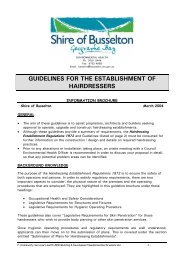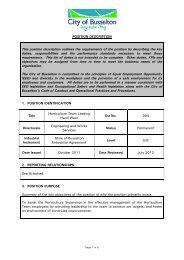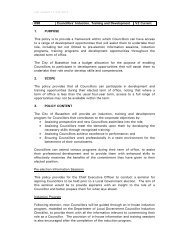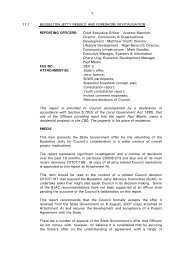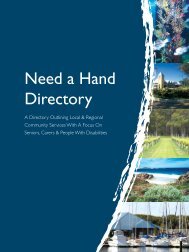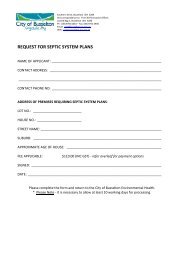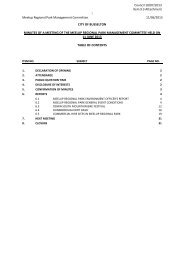Attachments 11.4 and 11.5 - City of Busselton
Attachments 11.4 and 11.5 - City of Busselton
Attachments 11.4 and 11.5 - City of Busselton
Create successful ePaper yourself
Turn your PDF publications into a flip-book with our unique Google optimized e-Paper software.
ATTACHMENT C - TREATMENT OPTIONS CONSIDERED IN THE COUNCILLOR WORKSHOP OF MAY 2011<br />
ITEM <strong>11.4</strong> COUNCIL 12/10/2011<br />
2<br />
Another approach completely is to physically sink the algae to the bottom <strong>of</strong><br />
the river through the use <strong>of</strong> flocculating clays <strong>and</strong> other materials. In fact<br />
one such trial <strong>of</strong> a prospective material has already been trialled on the LVR.<br />
These methods rely on the added material to bind together the algal cells so<br />
that they become heavier <strong>and</strong> sink. Much work has been conducted<br />
overseas mainly on din<strong>of</strong>lagellate phytoplankton <strong>and</strong> relatively little on blue<br />
green algae which are the main LVR Phytoplankton type.<br />
Research in China has shown that Loess clays can remove algae <strong>and</strong> that<br />
clays mixed with Chitonase are especially effective.<br />
Chitonase is a natural product made from ground up mollusc shells. All <strong>of</strong><br />
these products only remove algae from the surface to the bottom. However<br />
when the algal cells breakdown the nutrient is released <strong>and</strong> again becomes<br />
available for algal growth. This treatment therefore also needs to be used in<br />
conjunction with another product, such as Phoslock, that binds the<br />
phosphorous so it is not available.<br />
Chitonase is currently quite expensive. The price has been driven up by it’s<br />
medicinal uses.<br />
Algal removal for the LVR<br />
Another approach is to physically remove the algae from the river which is<br />
difficult given the buoyant nature <strong>of</strong> the blue greens involved. During the<br />
Jan 2000 algal bloom in the Swan suction trucks were effectively used to<br />
remove algae, which was then transported to a Water corporation Waste<br />
water treatment facility. The technique works because the buoyant algae<br />
floats to the surface in the vacuum truck <strong>and</strong> the algae clear water can be<br />
decanted from the bottom which reduces the number <strong>of</strong> truck journeys<br />
required.<br />
The disadvantage is that once the algae is removed more will grow due to<br />
the abundant supply <strong>of</strong> phosphorus <strong>and</strong> so treatments <strong>of</strong> Phoslock would<br />
also be required. The advantage <strong>of</strong> physical removal is that both nutrients<br />
<strong>and</strong> organic sludge are removed from the system. This option has not been<br />
costed <strong>and</strong> would depend on disposal at Water Corporation site <strong>and</strong><br />
availability <strong>of</strong> vacuum trucks.<br />
Nutrisorb<br />
Nutrisorb is a by-product <strong>of</strong> the mineral s<strong>and</strong>s industry produced by Iluka. It<br />
has very good physical filtration properties <strong>and</strong> therefore is thought to be a<br />
good treatment to use within the catchment close to the source <strong>of</strong> the<br />
pollutants. For example, it could be used as a soil amendment around point<br />
sources such as dairy effluent ponds <strong>and</strong> paddocks where the effluent is<br />
disposed <strong>of</strong>, or diffuse sources such as paddocks as a top dressing which<br />
prevents nutrients from getting into creek lines.



